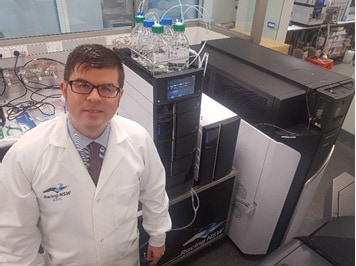Celebrating 50 Years of MS Innovation - User interviews February 2020
On the occasion of Shimadzu's 50th year of producing mass spectrometry instruments, we talk to researchers using Shimadzu MS instruments in their daily work and ask about their expectations for Shimadzu and the future of MS technology.

Dr. Adam Cawley
Science Manager, Australian Racing Forensic Laboratory, Racing NSW
Main field of study:
Equine Anti-Doping; a multidisciplinary field involving chemistry, biology, pharmacology and veterinary science.
1. How did you become familiar with Shimadzu?
I first used Shimadzu GCMS-QP2010 instruments for the analysis of urinary steroids in human anti-doping. After moving to equine anti-doping I have used Shimadzu GCMS-TQ8040 for improved sensitivity and specificity in the analysis of equine urinary steroids before expanding into analysis of several classes of drugs in equine plasma and urine using the LCMS-8050 and 8060 LC-MS-MS instruments.
2. What is your main field of research, and how are you utilizing Shimadzu equipment?
For the detection of peptide and protein drug molecules of interest to anti-doping we are developing methods of analysis using the Nexera Mikros Micro-Flow LC-MS-MS instrument to achieve robust micro-flow LC separations on normal-flow LC timescales coupled with pg/mL sensitivity. In collaboration with Shimadzu, our metabolomics research is focused on developing non-targeted steroidomic and lipid mediator profiling methods using the LCMS-9030 Q-ToF LC-MS instrument. In GC-MS, we are collaborating with Shimadzu to perform automated feature extraction from full-scan data acquired using the GCMS-QP2020 NX instrument in an effort to perform comparisons of total ion chromatograms within the sample population and within individual horses for the Racing NSW Equine Biological Passport (EBP).
3. What are your reasons for choosing Shimadzu equipment?
For routine target-based methods and metabolomics research the LCMS-9030 has demonstrated:
a. Speed – genuine 100 Hz for Data Independent Acquisition (DIA).
b. Stability – ≤2ppm mass accuracy from a single calibration performed over 2 weeks.
c. Collision Energy (CE) spread function to obtain MS/MS spectra at nominated and ± CE range.
More generally, my laboratory chooses Shimadzu equipment due to the excellent post-sales support provided. The availability of experienced applications and service engineer personnel, without the requirement for expensive contracts, sets Shimadzu apart from a customer perspective.
4. What trends are you seeing in your field with regards to the use of mass spectrometry?
In sports anti-doping and more general forensic toxicology there is growing awareness of the potential for non-targeted drug screening utilizing machine learning capabilities. Following the lead of medical research, anti-doping laboratories are also using OMICS-methods for the identification of outlier biomarkers from inter-individual (i.e. population) and intra-individual (i.e. longitudinal) studies.
5. What are your expectations for Shimadzu and for MS technology in general in the future?
In the next five years I expect to see greater integration of Artificial Intelligence (AI) software capabilities for improved efficiency in quality assurance, sample review and feature extraction contributing to laboratory workflows.



